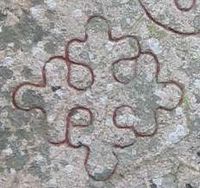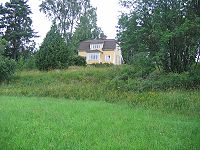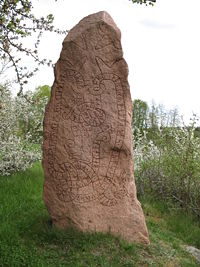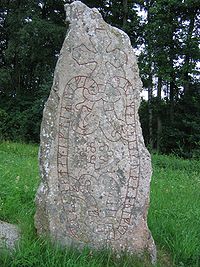
Risbyle Runestones
Encyclopedia

Uppland
Uppland is a historical province or landskap on the eastern coast of Sweden, just north of Stockholm, the capital. It borders Södermanland, Västmanland and Gästrikland. It is also bounded by lake Mälaren and the Baltic sea...
, Sweden
Sweden
Sweden , officially the Kingdom of Sweden , is a Nordic country on the Scandinavian Peninsula in Northern Europe. Sweden borders with Norway and Finland and is connected to Denmark by a bridge-tunnel across the Öresund....
, dating from the Viking Age
Viking Age
Viking Age is the term for the period in European history, especially Northern European and Scandinavian history, spanning the late 8th to 11th centuries. Scandinavian Vikings explored Europe by its oceans and rivers through trade and warfare. The Vikings also reached Iceland, Greenland,...
.
Descripiton

Rundata
The Scandinavian Runic-text Data Base is a project involving the creation and maintenance of a database of runic inscriptions. The project's goal is to comprehensively catalog runestones in a machine-readable way for future research...
catalog as U 160 and U 161, were engraved in Old Norse
Old Norse
Old Norse is a North Germanic language that was spoken by inhabitants of Scandinavia and inhabitants of their overseas settlements during the Viking Age, until about 1300....
with the Younger Futhark
Younger Futhark
The Younger Futhark, also called Scandinavian runes, is a runic alphabet, a reduced form of the Elder Futhark, consisting of only 16 characters, in use from ca. 800 CE...
in the early 11th century by the Viking
Viking
The term Viking is customarily used to refer to the Norse explorers, warriors, merchants, and pirates who raided, traded, explored and settled in wide areas of Europe, Asia and the North Atlantic islands from the late 8th to the mid-11th century.These Norsemen used their famed longships to...
Ulf of Borresta
Ulf of Borresta
Ulf of Borresta was not only a runemaster in eleventh century Uppland, Sweden, but also a successful Viking who returned from England three times with a share of the Danegeld...
(Báristaðir) who had partaken three times in the danegeld
Danegeld
The Danegeld was a tax raised to pay tribute to the Viking raiders to save a land from being ravaged. It was called the geld or gafol in eleventh-century sources; the term Danegeld did not appear until the early twelfth century...
in England
England
England is a country that is part of the United Kingdom. It shares land borders with Scotland to the north and Wales to the west; the Irish Sea is to the north west, the Celtic Sea to the south west, with the North Sea to the east and the English Channel to the south separating it from continental...
and raised the runestone U 336 in the same region. They were raised in memory of Ulf of Borresta's kinsman-by-marriage Ulf in Skolhamarr (Skålhammar).
One of the runestones, U 161, has the Eastern cross
Patriarchal cross
The Patriarchal cross is a variant of the Christian cross, the religious symbol of Christianity. Similar to the familiar Latin cross, the Patriarchal cross possesses a smaller crossbar placed above the main one, so that both crossbars are near the top. Sometimes the patriarchal cross has a short,...
which shows the influence of Byzantine culture on Sweden at this time through the Varangians who returned after having served the Emperor in Constantinople
Constantinople
Constantinople was the capital of the Roman, Eastern Roman, Byzantine, Latin, and Ottoman Empires. Throughout most of the Middle Ages, Constantinople was Europe's largest and wealthiest city.-Names:...
(see also the Greece Runestones
Greece Runestones
The Greece runestones are about 30 runestones containing information related to voyages made by Norsemen to the Eastern Roman Empire. They were made during the Viking Age until about 1100 and were engraved in the Old Norse language with Scandinavian runes...
and the Italy Runestones
Italy Runestones
The Italy Runestones are three or four Varangian Runestones from 11th century Sweden that talk of warriors who died in Langbarðaland , the Old Norse name for Italy...
). The cross is today the coat-of-arms of Täby Municipality
Täby Municipality
Täby Municipality is a municipality north of Stockholm in Stockholm County in east central Sweden. Its seat is located in the town of Täby...
. Both runestones are in the style Pr1, and they have a pronounced Ringerike character
Ringerike style
The Ringerike style is a Scandinavian animal style from the late 10th century and the 11th century, which evolved out of the earlier Mammen style. It has received its name from a group of runestones with animal and plant motifs in the Ringerike district north of Oslo. The most common motifs are...
.
The Skålhamra clan who asked Ulf of Borresta to make the runestones also had another couple of runestones made at Arkils tingstad
Arkils tingstad
Arkils tingstad is the remains of the Viking Age thing or assembly location of a hundred in Uppland, Sweden. It is situated on the outskirts of Stockholm...
across the lake, in addition to the runestone U 100
Uppland Runic Inscription 100
Uppland Runic Inscription 100 is the Rundata designation for a memorial runestone that is located in the forest where a path meets a bog near Skälby, which is about two kilometers northeast of Sollentuna, Stockholm County, Sweden, which was part of the historical province of...
at a path in the forest.
U 160

Runemaster
A runemaster or runecarver is a specialist in making runestones.Most early medieval Scandinavians were probably literate in runes, and most people probably carved messages on pieces of bone and wood. However, it was difficult to make runestones, and in order to master it one also needed to be a...
is considered to be Ulfr of Báristaðir himself.
Transliteration of the runes into Latin characters
- ulfkitil * uk * kui uk + uni + þiR × litu * rhisa × stin þina * iftiR * ulf * faþur * sin * kuþan on * buki * i skul(o)bri * kuþ * ilbi * ons * at * uk * salu * uk * kusþ muþiR * li anum lus * uk baratis
Transcription into Old Norse
- Ulfkætill ok Gyi ok Uni/Unni þæiR letu ræisa stæin þenna æftiR Ulf, faður sinn goðan. Hann byggi i Skulhambri. Guð hialpi hans and ok salu ok Guðs moðiR, le hanum lius ok paradis.
Translation in English
- Ulfketill and Gýi and Uni/Unni, they had this stone raised in memory of Ulfr, their good father. He lived in Skolhamarr. May God and God's mother help his spirit and soul; grant him light and paradise.
U 161

Transliteration of the runes into Latin characters
- ulfR * iuk i barstam * iftiR * ulf * i skulobri * mak * sin * kuþan * ulfkil lit akua
Transcription into Old Norse
- UlfR hiogg i Baristam æftiR Ulf i Skulhambri, mag sinn goðan. Ulfkell let haggva.
Translation in English
- Ulfr of Báristaðir cut (the stone) in memory of Ulfr in Skolhamarr, his good kinsman-by-marriage. Ulfkell had (it) cut.
Sources
- RundataRundataThe Scandinavian Runic-text Data Base is a project involving the creation and maintenance of a database of runic inscriptions. The project's goal is to comprehensively catalog runestones in a machine-readable way for future research...
- The article 5. Runriket - Risbyle on the site of Stockholm County Museum, retrieved July 7, 2007.

